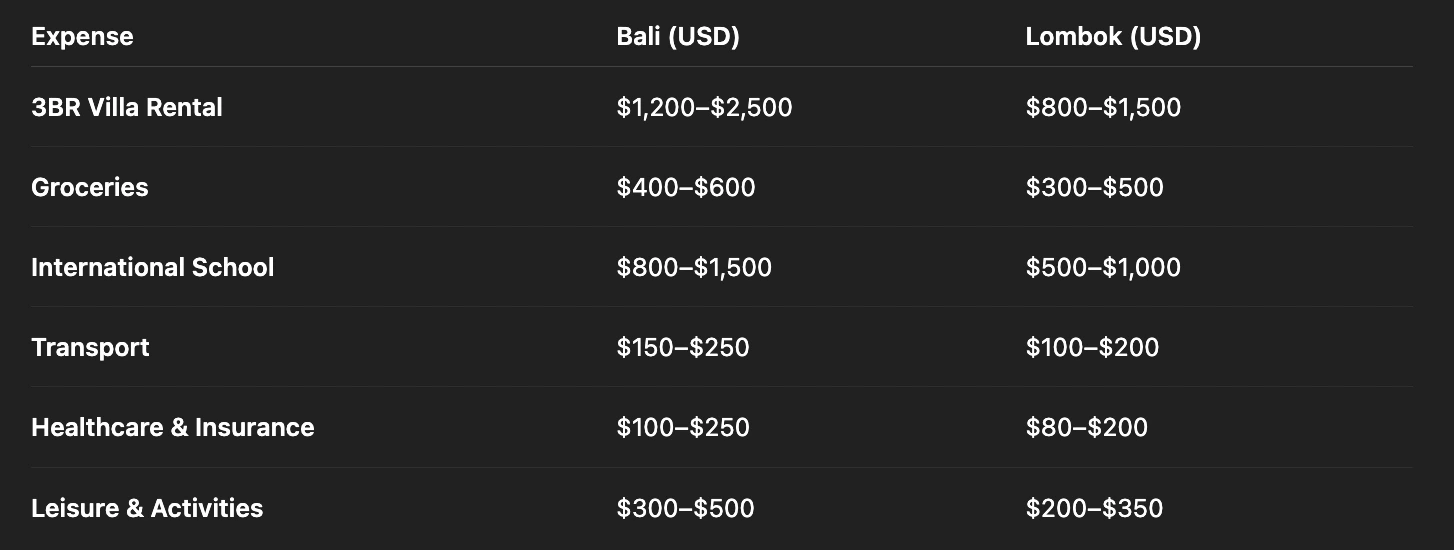Cost of Living in Lombok and Bali 2025: The Ultimate Guide for Expats & Investors to Stretch the Budget


Introduction: Why Cost of Living Matters for Expats
In recent years, Lombok has emerged as a serious contender to Bali for those seeking a tropical home base. While Bali remains Indonesia’s most famous destination for tourism, business, and expat life, Lombok is quickly gaining attention thanks to its quieter atmosphere, beautiful beaches, and more affordable lifestyle. For investors, entrepreneurs, and remote-working families, comparing the Cost of Living in Lombok and Bali is no longer just a nice-to-have exercise — it has become a critical step in planning a move or setting up a business.
The Cost of Living in Lombok and Bali affects nearly every decision: where to live, how to structure your business, which schools to choose for your children, and even what kind of lifestyle you can maintain. Bali offers a thriving international community, world-class dining, and advanced infrastructure, but those benefits often come at a premium. Lombok, on the other hand, offers lower housing costs, less traffic, and more space — but may have fewer international schools and lifestyle amenities.
For many expats, affordability is one of the biggest deciding factors when relocating. Understanding the Cost of Living in Lombok and Bali allows families and investors to stretch their budget, avoid surprises, and choose an island that matches their financial and lifestyle priorities.
Overview: Cost of Living in Lombok and Bali 2025
When discussing the Cost of Living in Lombok and Bali, it’s important to define exactly what we mean. Cost of living generally includes essential categories such as housing (rent or purchase prices), food and groceries, utilities, transportation, education, healthcare, and lifestyle expenses like dining out, entertainment, and leisure activities. These factors together shape the overall monthly or yearly budget for individuals, families, or businesses relocating to either island.
The Cost of Living in Lombok and Bali differs for several reasons. Bali’s international popularity has driven up demand for housing, villas, and land, making rental prices higher — particularly in areas like Canggu, Seminyak, and Ubud. Its well-developed infrastructure, wide variety of international restaurants, and abundance of co-working spaces also contribute to higher day-to-day spending. Lombok, while developing quickly, still offers lower land and rental prices, less crowded neighborhoods, and fewer premium-priced tourist zones. This means you can often rent a larger house or villa in Lombok for the same price as a smaller one in Bali.
Post-pandemic trends have further influenced the Cost of Living in Lombok and Bali. With the global shift toward remote work, Bali saw a surge in digital nomads and long-term visitors, which kept rental prices high and increased competition for desirable housing. Lombok, on the other hand, benefited from spillover interest as expats and investors began seeking more affordable, less saturated alternatives. As infrastructure projects such as the Mandalika development and new international schools continue to expand in Lombok, its cost of living is gradually increasing but still remains lower than Bali in most categories.
Understanding these dynamics gives expats and investors a clearer picture of where they might save money — or where they might need to spend more — when planning a move in 2025.
Housing Costs: Renting or Buying a Home
Housing is often the single largest expense that shapes the Cost of Living in Lombok and Bali, and this is where the two islands show the most striking differences.
In Bali, popular expat hubs like Canggu, Seminyak, Sanur, and Ubud command premium prices due to high demand from remote workers, long-term visitors, and investors. A modest 1-bedroom apartment in Canggu can cost between IDR 8–12 million (USD 500–750) per month, while a fully furnished 2–3-bedroom villa with a pool can range from IDR 25–40 million (USD 1,500–2,500) monthly, depending on proximity to the beach and amenities. Long-term lease options (5–25 years) in Bali’s prime locations often start around IDR 6–8 billion (USD 380,000–500,000) for a villa-sized plot.
Lombok offers a much more budget-friendly alternative for housing, significantly impacting the overall Cost of Living in Lombok and Bali comparison. In areas like Kuta Lombok, Senggigi, and Mataram, a similar 1-bedroom apartment may cost just IDR 4–7 million (USD 250–450) per month, while a 2–3-bedroom villa with a pool can be found for IDR 12–20 million (USD 750–1,250). Long-term leases are also more affordable, with 20-year land leases available for a fraction of Bali’s price, making Lombok attractive for investors looking to build.
Several factors influence these price differences. In Bali, proximity to beaches, international schools, co-working spaces, and thriving café culture drives up rental costs. The established expat community and tourist demand further add to competition for well-located properties. In contrast, Lombok offers larger plots of land, more privacy, and a slower pace of development — meaning you get more space for less money.
For anyone considering relocation, it’s clear that the Cost of Living in Lombok and Bali diverges most dramatically in the housing category. Families or investors seeking spacious properties at lower costs often find Lombok a better match, while those prioritizing Bali’s infrastructure and lifestyle may be willing to pay a premium.
Food & Groceries
Food is one of the most noticeable areas where the Cost of Living in Lombok and Bali differs. Both islands offer affordable local dining, but Bali tends to have a wider range of options and slightly higher prices.
Eating at a local warung is one of the most budget-friendly choices for expat families. A typical plate of nasi campur or mie goreng costs around IDR 20,000–30,000 (USD 1.25–2) in both Bali and Lombok, making it easy to keep food expenses low if you enjoy Indonesian cuisine. However, Western dining is where Bali’s prices rise. In Canggu, Seminyak, or Ubud, a Western-style meal for two can range from IDR 200,000–400,000 (USD 12–25), while in Lombok, especially outside of Kuta or Senggigi, the same meal might cost 10–15% less due to lower demand and overhead costs.
Groceries also vary. Local markets in both islands sell fresh vegetables, fruits, eggs, and fish at similar prices, often cheaper than supermarkets. However, Bali has more international supermarkets such as Pepito, Frestive, and Bali Direct, offering a wider range of imported goods — but at a higher price point. For example, imported cheese or almond milk might cost 20–30% more in Bali compared to Lombok, simply due to demand and distribution.
For a family of four, a weekly grocery basket with rice, fresh produce, chicken, milk, and snacks might cost IDR 1.5–2 million (USD 100–130) in Lombok, while in Bali, it can easily reach IDR 2–2.5 million (USD 130–160) if including imported products.
Education: International Schools & Fees
For expat families, education is one of the most significant factors influencing the Cost of Living in Lombok and Bali. Bali has long been known for its variety of international schools, offering globally recognized curricula such as IB (International Baccalaureate), Cambridge, and Montessori. Popular choices include Green School Bali, known for its eco-focused campus, Dyatmika School near Sanur, and Canggu Community School, all of which cater to expatriate children from preschool to high school.
In contrast, Lombok is still developing its international education sector. While there are a growing number of bilingual and private schools — particularly in Kuta and Mataram — the options remain more limited compared to Bali. Families seeking internationally accredited programs may need to homeschool or opt for online learning if they choose to live in Lombok full-time.
When it comes to tuition, the difference is significant. In Bali, annual fees for international schools range from USD 5,000–8,000 for preschool and primary levels, and up to USD 15,000–20,000 per year for secondary and high school programs at top institutions. Lombok’s private schools, on the other hand, tend to be more affordable, with tuition ranging between USD 2,000–5,000 per year, depending on the curriculum and level.
These education costs play a major role in shaping the overall Cost of Living in Lombok and Bali. Families seeking top-tier international schooling often find Bali more convenient but also more expensive, while Lombok can be a cost-saving option if they are flexible with school choice or combine it with homeschooling.
Transportation & Daily Mobility
Transportation is another key factor when comparing the Cost of Living in Lombok and Bali, as it influences both time and money spent daily. For most expats, scooters are the most popular mode of transport due to their affordability and flexibility. In Bali, scooter rental typically costs USD 50–80 per month, with fuel costing less than USD 2 per full tank. Lombok offers even cheaper scooter rentals, averaging USD 40–60 per month, thanks to lower demand and lighter traffic.
For families who prefer cars, Bali has a wide selection of car rentals, ranging from USD 300–600 per month for long-term agreements. Buying a second-hand car can cost anywhere between USD 8,000–20,000 depending on the brand and condition. Lombok generally has fewer options for car rentals, but prices are slightly cheaper, and the roads are less congested — making car ownership more appealing for long-term residents.
Ride-hailing services like Gojek and Grab are widely available in Bali, making short trips convenient and affordable (starting around USD 1–2 per ride). Lombok has limited availability for ride-hailing, which may require expats to rely more on private drivers or self-driving.
Traffic congestion is another factor that indirectly impacts the Cost of Living in Lombok and Bali. Bali, especially Canggu and Denpasar, is notorious for rush-hour gridlock, which can lead to lost time and higher fuel use. Lombok, by contrast, offers smoother commutes and less stressful travel, adding to its appeal for families seeking a calmer lifestyle.
Healthcare & Insurance
Healthcare quality and availability are major factors influencing the Cost of Living in Lombok and Bali, especially for expat families who want peace of mind. Bali is well-known for its international-standard hospitals such as BIMC Hospital, Siloam, and Kasih Ibu, offering English-speaking doctors, 24/7 emergency care, and a wide range of specialties. GP consultations typically cost USD 25–50 per visit, while emergency care or specialist visits can range from USD 80–200 depending on the treatment required.
Lombok’s healthcare infrastructure is developing, with facilities like RSUD Provinsi NTB and private hospitals in Mataram improving their services. However, for more complex treatments, many expats still travel to Bali or even Singapore. GP visits in Lombok are usually cheaper, around USD 15–30, but fewer clinics offer international-level service, which is an important consideration for those with children.
Health insurance is highly recommended for both islands. International health insurance premiums can cost USD 1,000–3,000 annually per adult, depending on coverage level. Local insurance options are cheaper but may have limited hospital networks.
Ultimately, healthcare costs can significantly influence the Cost of Living in Lombok and Bali, as families in Bali may spend more for premium facilities, while Lombok residents might save on routine care but budget extra for travel in case of serious medical needs.
Entertainment, Leisure, and Lifestyle
Entertainment and leisure play a big role in shaping the Cost of Living in Lombok and Bali, especially for families and remote workers seeking balance between work and play. Bali offers a wide variety of entertainment options — from iconic beach clubs in Canggu and Seminyak (entry fees or minimum spends range from USD 20–50 per person) to yoga studios, boutique gyms, and world-class spas. Monthly gym memberships in Bali can range from USD 50–120, and yoga class passes cost about USD 10–15 per session.
Family activities are abundant in Bali, with weekend outings including water parks, play centers, or trips to the cinema costing USD 5–10 per ticket. Bali’s lively calendar of festivals, cultural performances, and community events can also add variety (and cost) to expat life.
Lombok, by contrast, offers a slower, quieter lifestyle. While there are fewer beach clubs or luxury spas, activities like surfing, hiking, and exploring waterfalls are often free or low-cost. Movie theaters and kids’ play areas are limited, but nature-based activities provide affordable family entertainment. Monthly gym memberships are generally cheaper (around USD 30–70).
Ultimately, lifestyle choices can make the Cost of Living in Lombok and Bali either modest or premium. Bali allows for a more vibrant, social, and event-filled life, while Lombok encourages a calmer, outdoors-focused routine that can significantly lower entertainment expenses.
Utilities & Internet
Utilities are a key part of the Cost of Living in Lombok and Bali, and they can vary significantly depending on lifestyle and property size. Electricity is usually the biggest expense, especially if you run air conditioning regularly. In Bali, monthly electricity bills for a family living in a 2–3BR villa typically range between USD 80–150, while Lombok is often slightly cheaper due to lower demand and smaller villa sizes.
Water bills remain relatively low on both islands, averaging USD 10–20 per month, though some villas include water in the rental price.
Internet speed and reliability are where Bali has a clear advantage. Bali offers multiple fiber-optic providers (Biznet, Indihome) with packages ranging from USD 25–50 per month for speeds suitable for remote work. Lombok is catching up but may still experience slower connections or outages, particularly outside of Mataram or Kuta Lombok, which can be a key consideration for digital nomads.
Overall, while utilities are slightly cheaper in Lombok, Bali’s superior internet infrastructure can make a difference in work productivity — an essential factor when calculating the true Cost of Living in Lombok and Bali for remote workers and entrepreneurs.
Sample Monthly Budgets
To give a clear picture of the Cost of Living in Lombok and Bali, let’s break down a sample monthly budget for a family of four.

This comparison shows that an average family of four can expect to spend 15–25% less on the overall Cost of Living in Lombok and Bali, with the biggest savings coming from housing and schooling. In Lombok, long-term villa rentals are more affordable, and even prime areas like Kuta Lombok or Senggigi offer spacious 3-bedroom homes for under USD 1,500 per month — a fraction of Bali’s prices in Canggu or Seminyak.
Groceries are also slightly cheaper in Lombok, especially for local produce, though Bali offers more imported goods and specialty items. Education is another major differentiator, as Bali has more international schools with higher fees, whereas Lombok’s growing private school network keeps tuition lower.
Transportation costs are lighter in Lombok as traffic congestion is minimal, meaning less fuel consumption and shorter commutes. Leisure and entertainment spending can also be lower since Lombok has a slower pace of life and fewer temptations for high-end spending.
For many families, these savings mean they can enjoy a more relaxed lifestyle or allocate extra funds toward travel, savings, or business investments — making Lombok a financially attractive alternative while still keeping a high quality of life.
Challenges Beyond the Numbers
While the Cost of Living in Lombok and Bali provides a clear financial comparison, numbers alone don’t tell the full story. Lombok, despite its lower housing and schooling costs, still has limited options for international education. Families with older children may find fewer choices for IB or Cambridge curriculum schools compared to Bali, where institutions like Green School, Dyatmika, and Canggu Community School offer a wide range of programs.
Healthcare access is another consideration. Bali has internationally accredited hospitals such as BIMC and Siloam, whereas Lombok’s facilities are improving but may still require travel to Bali for complex treatments.
Additionally, Lombok has a smaller international community, which can affect social opportunities, networking, and lifestyle activities for expat families. Those who thrive in vibrant expat hubs might feel more isolated in Lombok unless they are seeking a quieter, more secluded life.
Ultimately, the Cost of Living in Lombok and Bali must be balanced with personal priorities such as education quality, healthcare access, and community engagement — ensuring that the move aligns with both budget and lifestyle goals.
Which Island Should You Choose?
Choosing between Lombok and Bali ultimately comes down to balancing budget with lifestyle needs. The Cost of Living in Lombok and Bali shows a clear financial difference — Lombok is generally 15–25% more affordable, especially in housing and daily expenses. This makes it an attractive choice for families or investors looking for quieter surroundings, more space for the money, and a slower pace of life.
However, Bali remains the top pick for those who prioritize convenience and access to established infrastructure. With a wide selection of international schools, world-class hospitals, vibrant coworking spaces, and a thriving expat network, Bali is ideal for families and entrepreneurs who need strong connectivity and community support.
The decision isn’t just about the Cost of Living in Lombok and Bali — it’s about finding the right balance between financial goals and lifestyle preferences. Whether you choose Bali for its convenience or Lombok for its tranquility, planning ahead is crucial.
For a smooth transition, consider consulting relocation and business setup experts who understand the local regulations, permits, and cultural nuances. This ensures you can focus on enjoying island life while staying compliant and maximizing your investment.
Source:

.png)









